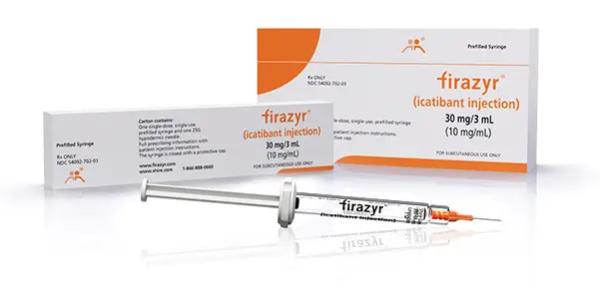Icatibant Side Effects
Applies to icatibant: subcutaneous solution.
Common side effects of icatibant
Some side effects of icatibant may occur that usually do not need medical attention. These side effects may go away during treatment as your body adjusts to the medicine. Also, your health care professional may be able to tell you about ways to prevent or reduce some of these side effects.
Check with your health care professional if any of the following side effects continue or are bothersome or if you have any questions about them:
More common
Less common
- dizziness
Serious side effects of icatibant
Along with its needed effects, icatibant may cause some unwanted effects. Although not all of these side effects may occur, if they do occur they may need medical attention.
Check with your doctor immediately if any of the following side effects occur while taking icatibant:
Less common
For healthcare professionals
Applies to icatibant: subcutaneous solution.
General
The most common adverse reactions were injection site reactions, pyrexia, transaminase increased, dizziness, and rash.[Ref]
Local
- Very common (10% or more): Injection site reaction (97%)[Ref]
Injection site reaction includes bruising, hematoma, burning, erythema, hypoesthesia, irritation, numbness, edema, pain, pressure sensation, pruritus, swelling, urticaria, or warmth at the site of injection.[Ref]
Dermatologic
- Common (1% to 10%): Rash, pruritus, erythema
- Uncommon (0.1% to 1%): Generalized urticaria[Ref]
Respiratory
- Common (1% to 10%): Nasopharyngitis, nasal congestion
- Uncommon (0.1% to 1%): Pharyngitis, asthma, cough[Ref]
Gastrointestinal
- Common (1% to 10%): Gastroenteritis, nausea
- Uncommon (0.1% to 1%): Vomiting[Ref]
Nervous system
- Common (1% to 10%): Dizziness, headache[Ref]
Other
Hepatic
- Common (1% to 10%): Transaminase increased
- Uncommon (0.1% to 1%): Liver function test abnormal[Ref]
Hematologic
- Common (1% to 10%): Prothrombin time prolonged[Ref]
Renal
- Common (1% to 10%): Blood creatinine phosphokinase increased[Ref]
Metabolic
- Uncommon (0.1% to 1%): Weight increased, blood glucose increased, hyperuricemia, hyperglycemia[Ref]
Immunologic
- Uncommon (0.1% to 1%): Herpes zoster
- Frequency not reported: Anti-icatibant antibodies[Ref]
Cardiovascular
- Uncommon (0.1% to 1%): Hot flush[Ref]
Genitourinary
- Uncommon (0.1% to 1%): Proteinuria[Ref]
Musculoskeletal
- Uncommon (0.1% to 1%): Muscle spasm[Ref]
References
1. Cerner Multum, Inc. "UK Summary of Product Characteristics."
2. Cerner Multum, Inc. "Australian Product Information."
3. (2011) "Product Information. Firazyr (icatibant)." Shire US Inc
Frequently asked questions
More about icatibant
- Check interactions
- Compare alternatives
- Pricing & coupons
- Reviews (10)
- Dosage information
- During pregnancy
- Drug class: hereditary angioedema agents
- Breastfeeding
- En español
Patient resources
Other brands
Professional resources
Other brands
Related treatment guides
Further information
Icatibant side effects can vary depending on the individual. Always consult your healthcare provider to ensure the information displayed on this page applies to your personal circumstances.
Some side effects may not be reported. You may report them to the FDA.

